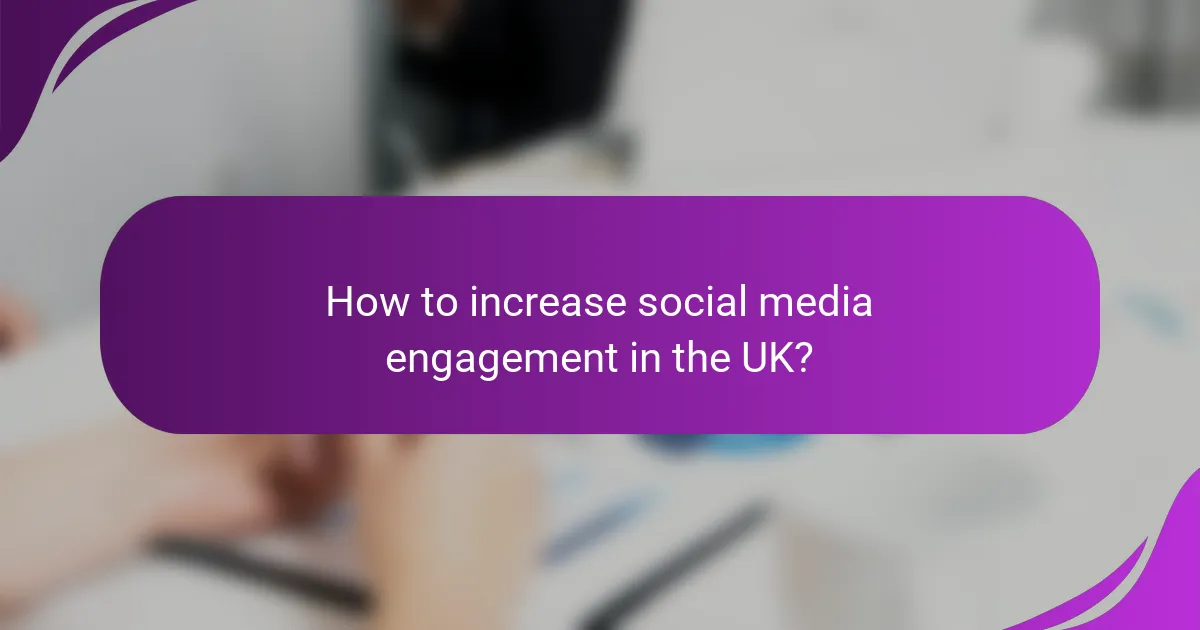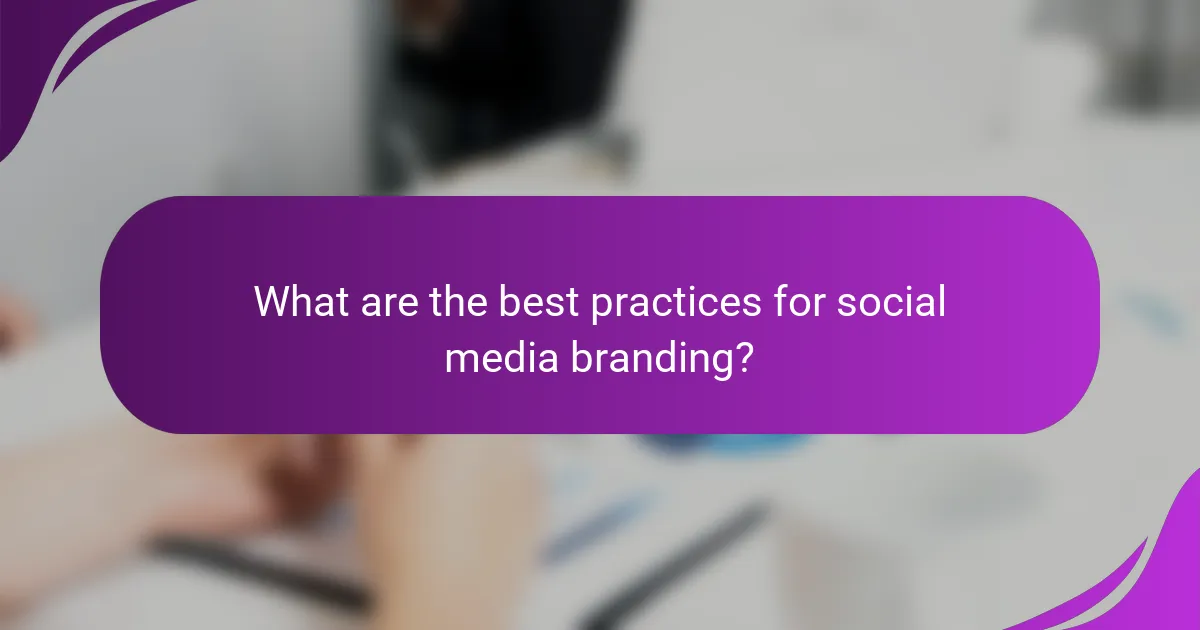In today’s digital landscape, social media plays a crucial role in enhancing engagement, outreach, and brand awareness. By creating resonant content and utilizing interactive strategies, brands can foster meaningful interactions with their audiences. Additionally, leveraging analytical tools can streamline outreach efforts and provide valuable insights into brand recognition and public perception.

How to increase social media engagement in the UK?
To increase social media engagement in the UK, focus on creating content that resonates with your audience and encourages interaction. Strategies such as utilizing interactive content, leveraging user-generated content, and implementing targeted campaigns can significantly boost engagement levels.
Utilize interactive content
Interactive content, such as polls, quizzes, and contests, actively involves users and encourages them to participate. This type of content can lead to higher engagement rates as users are more likely to share their opinions and experiences.
Consider using tools like Instagram Stories or Facebook Live to create real-time interactions. For instance, a quiz related to your brand can not only entertain but also educate your audience about your products or services.
Leverage user-generated content
User-generated content (UGC) involves sharing content created by your customers, which can enhance authenticity and trust. Encouraging customers to share their experiences with your brand can create a sense of community and increase engagement.
For example, you can run a campaign asking customers to post photos of themselves using your products with a specific hashtag. This not only promotes your brand but also allows you to showcase real-life testimonials, making your social media presence more relatable.
Implement targeted campaigns
Targeted campaigns focus on specific audience segments, ensuring that your content reaches the right people. By analyzing demographics and interests, you can tailor your messaging to resonate with particular groups, increasing the likelihood of engagement.
Utilize tools like Facebook Ads or Instagram Ads to create targeted promotions. For instance, if you have a new product aimed at young adults, you can set your campaign to reach users within that age range in the UK, maximizing relevance and interaction.

What tools enhance social media outreach?
Several tools can significantly improve social media outreach by streamlining scheduling, providing analytics, and tracking engagement. Utilizing these tools can help brands effectively manage their online presence and enhance their interaction with audiences.
Hootsuite for scheduling
Hootsuite is a popular tool for scheduling social media posts across multiple platforms. It allows users to plan content in advance, ensuring consistent posting even during busy periods.
With Hootsuite, you can customize posts for different platforms, analyze the best times to post, and manage all your accounts from a single dashboard. This can save time and increase the effectiveness of your outreach efforts.
Buffer for analytics
Buffer provides comprehensive analytics that help you understand how your content performs on social media. By tracking metrics such as engagement rates and click-through rates, you can refine your strategy based on real data.
Using Buffer, you can compare the performance of different posts and identify trends over time. This insight allows you to focus on the types of content that resonate most with your audience, enhancing your outreach efforts.
Sprout Social for engagement tracking
Sprout Social specializes in tracking engagement across various social media platforms. It offers features that allow you to monitor interactions, respond to comments, and analyze audience sentiment.
By using Sprout Social, you can gain valuable insights into how your audience engages with your brand. This information can inform your outreach strategies, helping you to foster stronger relationships with your followers and improve brand awareness.

How to measure brand awareness on social media?
Measuring brand awareness on social media involves evaluating how well your target audience recognizes and recalls your brand. Key metrics include engagement rates, reach, impressions, and sentiment analysis to gauge public perception.
Track engagement metrics
Engagement metrics are crucial for understanding how users interact with your content. This includes likes, shares, comments, and overall interactions relative to your follower count. A high engagement rate typically indicates strong brand awareness.
To effectively track these metrics, use social media analytics tools that provide insights into user behavior. Aim for engagement rates that are above industry averages, which can vary but often fall between 1% to 5% for most platforms.
Analyze reach and impressions
Reach refers to the number of unique users who see your content, while impressions indicate how many times your content is displayed, regardless of clicks. Monitoring these figures helps you understand how widely your brand is being recognized.
Utilize platform analytics to track these metrics over time. A steady increase in reach and impressions suggests growing brand awareness. Consider comparing these metrics against your content strategies to identify what resonates best with your audience.
Conduct brand sentiment analysis
Brand sentiment analysis evaluates how people feel about your brand based on their social media interactions. This can be done through monitoring comments, reviews, and mentions across platforms to gauge positive, negative, or neutral sentiments.
Employ sentiment analysis tools that can categorize and quantify public opinion. Regularly assess sentiment trends to identify potential issues or opportunities for enhancing brand perception. Aim for a predominantly positive sentiment to indicate strong brand awareness and loyalty.

What are the best practices for social media branding?
Effective social media branding involves creating a cohesive identity across platforms, engaging with your audience, and telling compelling stories. Implementing these best practices can significantly enhance your brand’s visibility and connection with followers.
Maintain consistent branding
Consistent branding across social media channels helps establish recognition and trust. Use the same logo, color scheme, and tone of voice in your posts to create a unified image.
Consider developing a style guide that outlines your brand’s visual elements and messaging. This guide will ensure that all team members adhere to the same standards, which is crucial for maintaining brand integrity.
Engage with followers regularly
Regular engagement with your followers fosters a sense of community and loyalty. Respond to comments, answer questions, and acknowledge user-generated content to show that you value your audience’s input.
Establish a posting schedule that includes interactive content such as polls, Q&A sessions, or live videos. Aim to interact with your audience multiple times a week to keep your brand top-of-mind.
Utilize storytelling techniques
Storytelling can make your brand more relatable and memorable. Share narratives about your brand’s journey, customer experiences, or behind-the-scenes insights to create an emotional connection with your audience.
Incorporate visuals and multimedia elements to enhance your stories. Use images, videos, or infographics to illustrate key points and engage viewers more effectively.

What criteria to consider when choosing a social media platform?
When selecting a social media platform, consider factors like your target audience, the type of content you plan to share, and the platform’s unique features. Each platform caters to different demographics and content styles, which can significantly impact your engagement and brand awareness efforts.
Target audience demographics
Understanding the demographics of your target audience is crucial when choosing a social media platform. Platforms like Facebook and Instagram tend to attract a broad age range, while TikTok skews towards younger users, typically under 30. Knowing where your audience spends their time can help you focus your efforts effectively.
Consider the geographic location and interests of your audience as well. For instance, LinkedIn is ideal for B2B engagement, while platforms like Snapchat may be better for reaching a younger, more casual audience. Tailoring your choice based on these factors can enhance your outreach.
Content type suitability
The type of content you intend to create plays a significant role in platform selection. Visual content, such as images and videos, thrives on Instagram and TikTok, while text-based content may perform better on Twitter and LinkedIn. Assessing the strengths of each platform can guide you in presenting your brand effectively.
Additionally, consider the format of your content. If you plan to share long-form articles, platforms like LinkedIn or Medium may be more suitable. Conversely, if your focus is on short, engaging posts, platforms like Instagram or Twitter could be more advantageous. Aligning your content type with the platform’s capabilities will maximize engagement.
